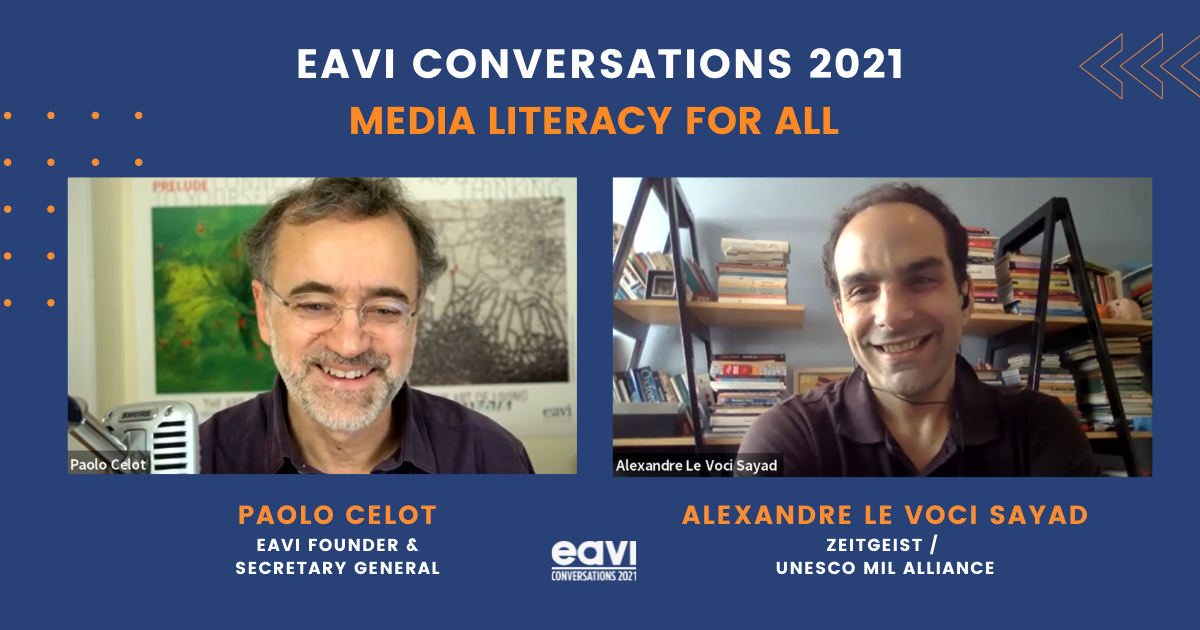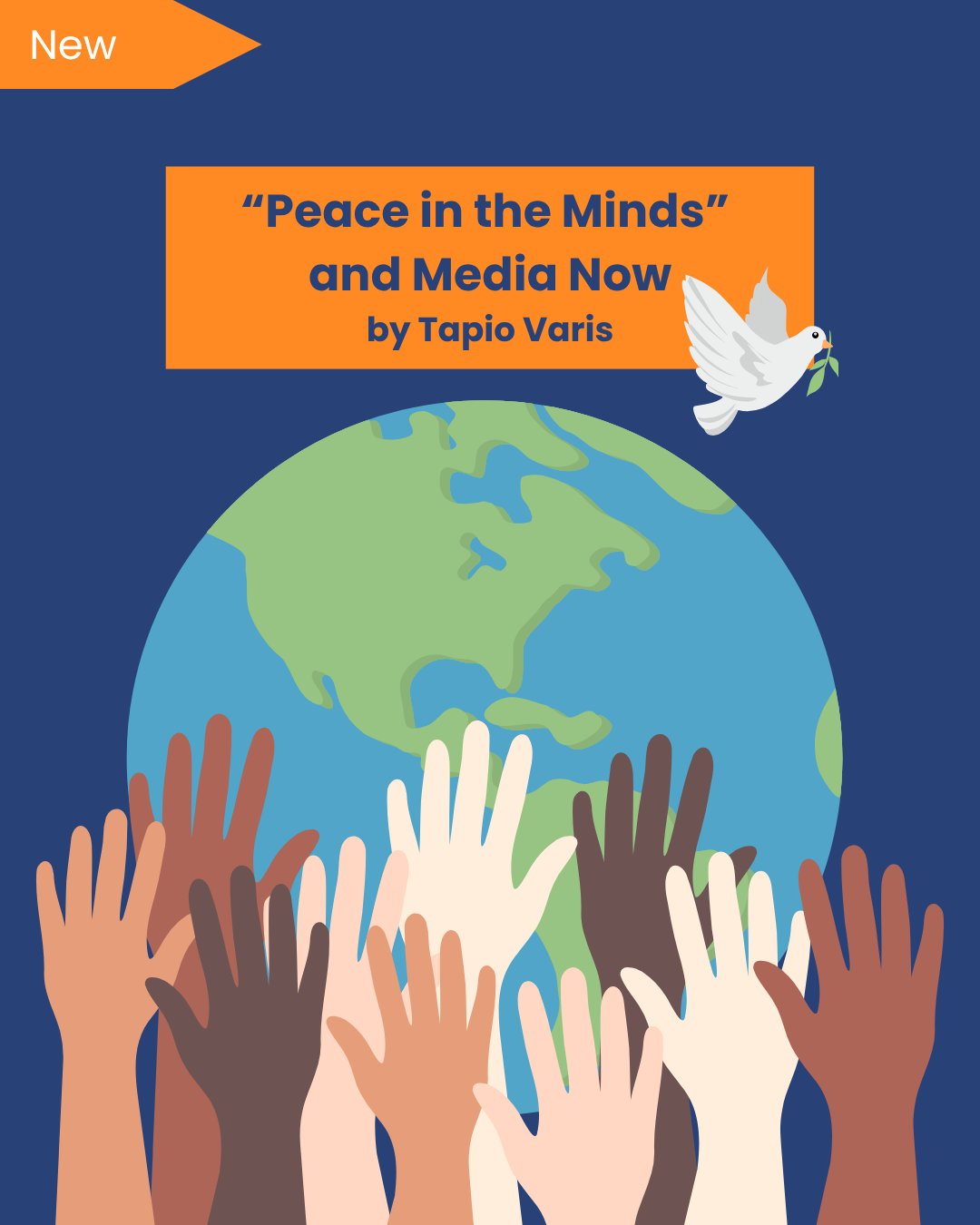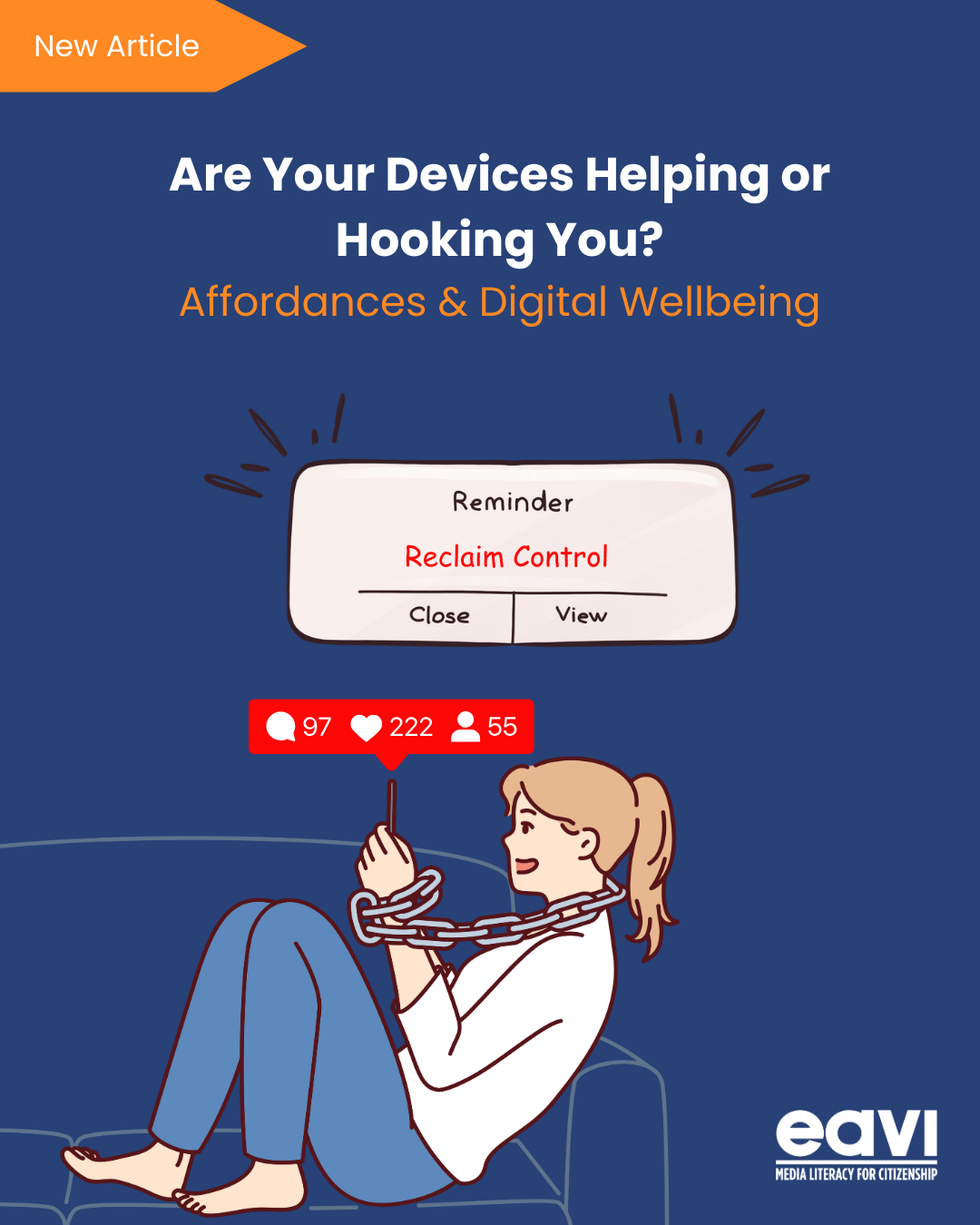Conclusions drawn from the discussion with Alexandre Le Voci Sayad – 30th of November (EAVI Conversations 2021)

Some topics are so complex that we cannot look at them from just one side. Therefore, we should take a multidisciplinary approach to tackle an issue or understand it better from different angles. Similarly, media literacy is a subject requiring a multidisciplinary approach to be fully comprehensible.
In which way should we talk about media literacy for people to receive and understand our message?
Teachers have an important role to play in this. They can use media literacy to transform educational systems, revolutionize school curricula and update lesson activities. In teaching media literacy, teachers should play the role of facilitators, using project-based learning and a multidisciplinary approach. Students should be able to express their voice, beliefs and concerns related to the media world. Therefore, rather than teaching media literacy as a separate subject, teachers should combine real-life experiences and media-related topics to promote awareness and knowledge across the different subjects. Learners should be part of a larger project at the end of which they can create a tangible product and develop their skills. As Paulo Freirepointed out, education should focus on participatory culture. Teaching and learning are an exchange process where learners and educators should learn together and develop their skills. Through this approach, learners can develop their critical consciousness and a much deeper one than critical literacy.
To realise the above, teachers should be trained in these approaches as part of their studies and thus teacher training should also be seen as a prerequisite for developing media literacy. However, teachers are not trained everywhere in this teaching and learning methodology. According to Alexandre Le Voci Sayad, we should invest in updating curricula so that graduates are confident and able to work with media literacy and project-based learning plans, promoting these skills to their students. Everyone has the right to acquire media literacy skills, and teacher’s empowerment could prove valuable.
Apart from teachers, everyone should realise the importance of media literacy. Media literacy is a well-known term among experts and those who are trying to tackle all media-related issues. During the conversation with Alexandre, it was found that 2/3 of the participants knew what media literacy was, while 1/3 claimed they were experts.
However, we can state that most people do not know exactly what media literacy is, especially outside of the experts’ bubble. How can we reach them and have more impact?
First of all, according to Alexandre, media literacy is a lifelong process and should be embedded in the framework of lifelong learning worldwide. It should not only be seen as schools’ responsibility; instead variety of actors should promote the concept of media literacy for all from a lifelong learning perspective. We need more education and cooperation among different stakeholders to strengthen the role of media literacy in education. It should not be treated as a separate subject, but a cross-cutting one. In Europe, for example, media literacy is a separate subject and often it is not linked to other courses.
Governments, schools, and CSOs in different countries are active in addressing media-related problems and in promoting media literacy among their citizens. Sometimes they do get positive results; unfortunately often their actions are not enough. 65% of participants were not satisfied with what the above actors are doing in terms of media literacy in their respective countries, while 35% thought they are doing a good job.
The truth is that governments are not investing in their citizens, in their people. Media literacy introduction and development need bottom-up approaches, and prior to that, governments need to create some kind of fertile ground for this approach to be effective.
To help others understand what media literacy is, let’s make it simpler: it is the ability to use media well. That sounds easy, doesn’t it? A good example of how to make media literacy accessible to everyone is to teach art and create videos. People should be oriented to sources that help them develop their skills and entertain them at the same time, and for this reason, academic resources are not always the answer. To that end, experts should work with TV producers/ TV broadcasters to produce non-academic content and reach those who have no idea about media literacy. Think of documentaries about climate change; they have succeeded in raising awareness about environmental issues.
Ultimately, we need to reach people the way they want to be reached by having a specific strategy for the media literacy community. We need to be aware of the importance of media literacy. We need practical and concrete good practices we can build upon.
The responsibility of a good pedagogy lies not only with the schools but also with the government. For the future, as Alexandre said, we should invest more in internet accessibility everywhere in the world and include media literacy in a lifelong learning policy. Let us get the media literacy ecosystem going! Let us create a Sesame Street of media literacy!
Are you interested in watching the different sessions of the EAVI Conversations 2021?
Conclusions drawn from the discussion with Alexandre Le Voci Sayad – 30th of November (EAVI Conversations 2021)

Some topics are so complex that we cannot look at them from just one side. Therefore, we should take a multidisciplinary approach to tackle an issue or understand it better from different angles. Similarly, media literacy is a subject requiring a multidisciplinary approach to be fully comprehensible.
In which way should we talk about media literacy for people to receive and understand our message?
Teachers have an important role to play in this. They can use media literacy to transform educational systems, revolutionize school curricula and update lesson activities. In teaching media literacy, teachers should play the role of facilitators, using project-based learning and a multidisciplinary approach. Students should be able to express their voice, beliefs and concerns related to the media world. Therefore, rather than teaching media literacy as a separate subject, teachers should combine real-life experiences and media-related topics to promote awareness and knowledge across the different subjects. Learners should be part of a larger project at the end of which they can create a tangible product and develop their skills. As Paulo Freirepointed out, education should focus on participatory culture. Teaching and learning are an exchange process where learners and educators should learn together and develop their skills. Through this approach, learners can develop their critical consciousness and a much deeper one than critical literacy.
To realise the above, teachers should be trained in these approaches as part of their studies and thus teacher training should also be seen as a prerequisite for developing media literacy. However, teachers are not trained everywhere in this teaching and learning methodology. According to Alexandre Le Voci Sayad, we should invest in updating curricula so that graduates are confident and able to work with media literacy and project-based learning plans, promoting these skills to their students. Everyone has the right to acquire media literacy skills, and teacher’s empowerment could prove valuable.
Apart from teachers, everyone should realise the importance of media literacy. Media literacy is a well-known term among experts and those who are trying to tackle all media-related issues. During the conversation with Alexandre, it was found that 2/3 of the participants knew what media literacy was, while 1/3 claimed they were experts.
However, we can state that most people do not know exactly what media literacy is, especially outside of the experts’ bubble. How can we reach them and have more impact?
First of all, according to Alexandre, media literacy is a lifelong process and should be embedded in the framework of lifelong learning worldwide. It should not only be seen as schools’ responsibility; instead variety of actors should promote the concept of media literacy for all from a lifelong learning perspective. We need more education and cooperation among different stakeholders to strengthen the role of media literacy in education. It should not be treated as a separate subject, but a cross-cutting one. In Europe, for example, media literacy is a separate subject and often it is not linked to other courses.
Governments, schools, and CSOs in different countries are active in addressing media-related problems and in promoting media literacy among their citizens. Sometimes they do get positive results; unfortunately often their actions are not enough. 65% of participants were not satisfied with what the above actors are doing in terms of media literacy in their respective countries, while 35% thought they are doing a good job.
The truth is that governments are not investing in their citizens, in their people. Media literacy introduction and development need bottom-up approaches, and prior to that, governments need to create some kind of fertile ground for this approach to be effective.
To help others understand what media literacy is, let’s make it simpler: it is the ability to use media well. That sounds easy, doesn’t it? A good example of how to make media literacy accessible to everyone is to teach art and create videos. People should be oriented to sources that help them develop their skills and entertain them at the same time, and for this reason, academic resources are not always the answer. To that end, experts should work with TV producers/ TV broadcasters to produce non-academic content and reach those who have no idea about media literacy. Think of documentaries about climate change; they have succeeded in raising awareness about environmental issues.
Ultimately, we need to reach people the way they want to be reached by having a specific strategy for the media literacy community. We need to be aware of the importance of media literacy. We need practical and concrete good practices we can build upon.
The responsibility of a good pedagogy lies not only with the schools but also with the government. For the future, as Alexandre said, we should invest more in internet accessibility everywhere in the world and include media literacy in a lifelong learning policy. Let us get the media literacy ecosystem going! Let us create a Sesame Street of media literacy!
Are you interested in watching the different sessions of the EAVI Conversations 2021?
Conclusions drawn from the discussion with Alexandre Le Voci Sayad – 30th of November (EAVI Conversations 2021)

Some topics are so complex that we cannot look at them from just one side. Therefore, we should take a multidisciplinary approach to tackle an issue or understand it better from different angles. Similarly, media literacy is a subject requiring a multidisciplinary approach to be fully comprehensible.
In which way should we talk about media literacy for people to receive and understand our message?
Teachers have an important role to play in this. They can use media literacy to transform educational systems, revolutionize school curricula and update lesson activities. In teaching media literacy, teachers should play the role of facilitators, using project-based learning and a multidisciplinary approach. Students should be able to express their voice, beliefs and concerns related to the media world. Therefore, rather than teaching media literacy as a separate subject, teachers should combine real-life experiences and media-related topics to promote awareness and knowledge across the different subjects. Learners should be part of a larger project at the end of which they can create a tangible product and develop their skills. As Paulo Freirepointed out, education should focus on participatory culture. Teaching and learning are an exchange process where learners and educators should learn together and develop their skills. Through this approach, learners can develop their critical consciousness and a much deeper one than critical literacy.
To realise the above, teachers should be trained in these approaches as part of their studies and thus teacher training should also be seen as a prerequisite for developing media literacy. However, teachers are not trained everywhere in this teaching and learning methodology. According to Alexandre Le Voci Sayad, we should invest in updating curricula so that graduates are confident and able to work with media literacy and project-based learning plans, promoting these skills to their students. Everyone has the right to acquire media literacy skills, and teacher’s empowerment could prove valuable.
Apart from teachers, everyone should realise the importance of media literacy. Media literacy is a well-known term among experts and those who are trying to tackle all media-related issues. During the conversation with Alexandre, it was found that 2/3 of the participants knew what media literacy was, while 1/3 claimed they were experts.
However, we can state that most people do not know exactly what media literacy is, especially outside of the experts’ bubble. How can we reach them and have more impact?
First of all, according to Alexandre, media literacy is a lifelong process and should be embedded in the framework of lifelong learning worldwide. It should not only be seen as schools’ responsibility; instead variety of actors should promote the concept of media literacy for all from a lifelong learning perspective. We need more education and cooperation among different stakeholders to strengthen the role of media literacy in education. It should not be treated as a separate subject, but a cross-cutting one. In Europe, for example, media literacy is a separate subject and often it is not linked to other courses.
Governments, schools, and CSOs in different countries are active in addressing media-related problems and in promoting media literacy among their citizens. Sometimes they do get positive results; unfortunately often their actions are not enough. 65% of participants were not satisfied with what the above actors are doing in terms of media literacy in their respective countries, while 35% thought they are doing a good job.
The truth is that governments are not investing in their citizens, in their people. Media literacy introduction and development need bottom-up approaches, and prior to that, governments need to create some kind of fertile ground for this approach to be effective.
To help others understand what media literacy is, let’s make it simpler: it is the ability to use media well. That sounds easy, doesn’t it? A good example of how to make media literacy accessible to everyone is to teach art and create videos. People should be oriented to sources that help them develop their skills and entertain them at the same time, and for this reason, academic resources are not always the answer. To that end, experts should work with TV producers/ TV broadcasters to produce non-academic content and reach those who have no idea about media literacy. Think of documentaries about climate change; they have succeeded in raising awareness about environmental issues.
Ultimately, we need to reach people the way they want to be reached by having a specific strategy for the media literacy community. We need to be aware of the importance of media literacy. We need practical and concrete good practices we can build upon.
The responsibility of a good pedagogy lies not only with the schools but also with the government. For the future, as Alexandre said, we should invest more in internet accessibility everywhere in the world and include media literacy in a lifelong learning policy. Let us get the media literacy ecosystem going! Let us create a Sesame Street of media literacy!








































































































































































